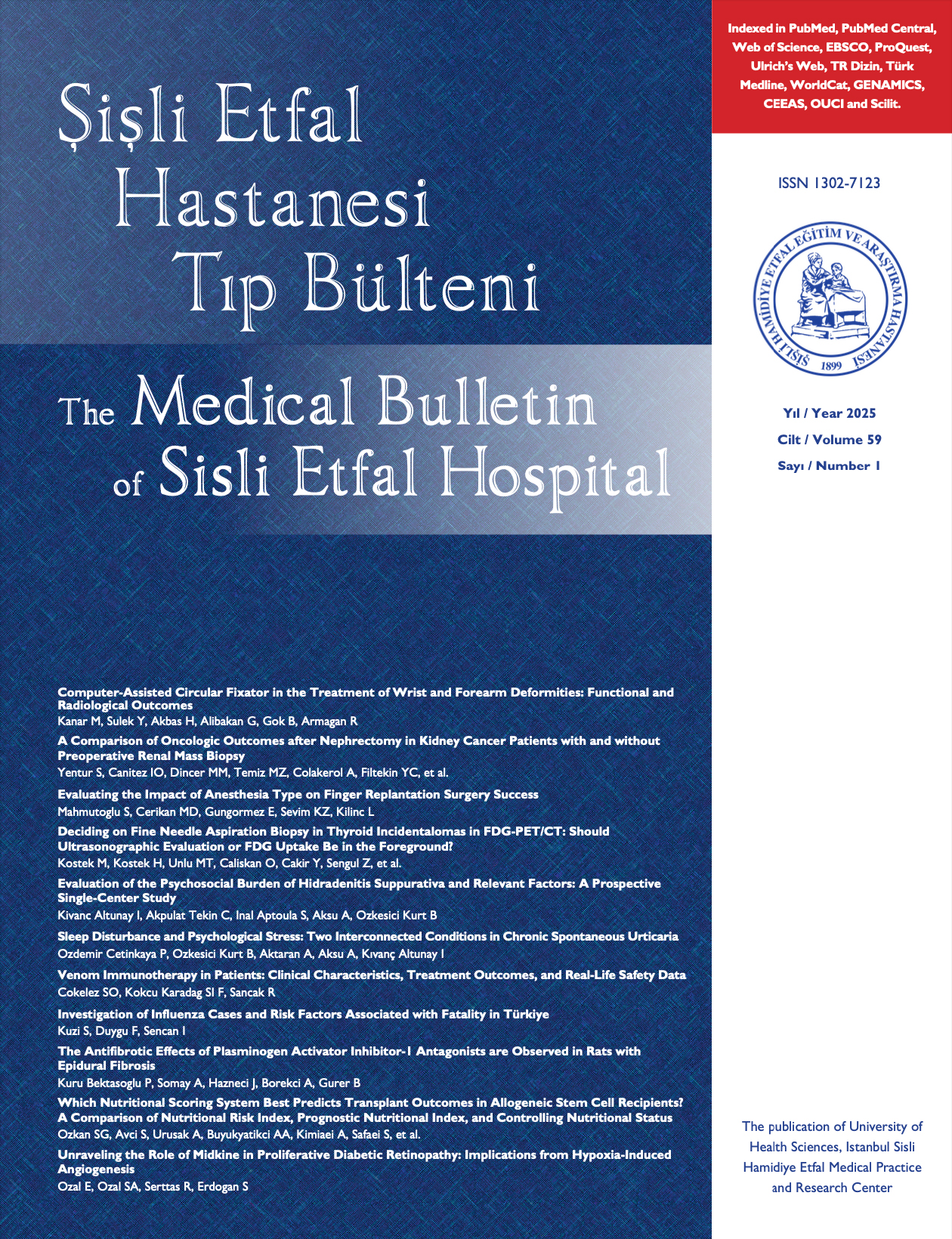
Pre-Operative Parameters Predicting Hemoglobin Decline Related to Percutaneous Nephrolithotomy
Mithat Eksi1, Deniz Noyan Ozlu2, Taner Kargi2, Abdullah Hizir Yavuzsan3, Ahmet Haciislamoglu2, Serdar Karadag2, Selcuk Sahin2, Ali Ihsan Tasci21Department of Urology, Arnavutköy State Hospital, Istanbul, Turkey2Department of Urology, University of Health Sciences Bakırköy Dr. Sadi Konuk Training and Research Hospital, Istanbul, Turkey
3Department of Urology, University of Health Sciences Sisli Hamidiye Etfal Training and Research Hospital, Istanbul, Turkey
Objectives: Percutaneous nephrolithotomy (PNL) for upper urinary tract stones is a minimally invasive, effective treatment modality. Despite its high success rates, its potential complications pose a risk. In this study, we aimed to determine the risk factors associated with bleeding which is one of PNLs most important complications.
Methods: The data of patients who underwent PNL between January 2017 and December 2018 were retrospectively analyzed. The median reduction in post-operative hemoglobin levels compared to preoperative levels was found to be 1.6 g/dl, which was accepted as the threshold value. The patients with hemoglobin decrease above the threshold were assigned as Group 1, and below the threshold as Group 2. Pre-operative, perioperative data, and stone characteristics of the patients were recorded.
Results: 169 patients, 85 patients in Group 1 and 84 patients in Group 2 were included in the study. The mean age of Group 1 was significantly higher (47.4±7.9 and 32±9.4 years, respectively, p=0.001) Sixteen in Group 1 (18.8%) and six in Group 2 (7, 1%) had a diagnosis of hypertension (HT) and a significant difference was found (p=0.038). The average stone burden was 2733±1121.3 mm3 in Group 1, and 2326.5±975.6 mm3 in Group 2. It was observed that there was a significantly higher stone burden in Group 1 (p=0.001). There was a significant difference between the groups in terms of mean operation time (84.4±7 and 76.2±9.9 min, respectively, p<0.001). When the complication rates were analyzed, complications were observed in 25 (29.4%) patients in Group 1 and 12 (14.2%) patients in Group 2, and a significant difference was found between both groups (p=0.019). Age and HT were found to be significant independent risk factors associated with hemoglobin decline in multivariate analyzes (p<0.001 and p<0.027, respectively).
Conclusion: In this study; advanced age, presence of HT, and high stone burden were found to be predictive of reductions in hemoglobin levels. Furthermore, a correlation of decreased hemoglobin levels was detected with operative times and occurrence of complications.
Perkütan Nefrolitotomi ile İlgili Hemoglobin Düşüşünü Öngören Preoperatif Parametreler
Mithat Eksi1, Deniz Noyan Ozlu2, Taner Kargi2, Abdullah Hizir Yavuzsan3, Ahmet Haciislamoglu2, Serdar Karadag2, Selcuk Sahin2, Ali Ihsan Tasci21Arnavutköy Devlet Hastanesi, Üroloji Kliniği, İstanbul2Sağlık Bilimleri Üniversitesi Bakırköy Dr. Sadi Konuk Eğitim ve Araştırma Hastanesi, Üroloji Kliniği, İstanbul
3Sağlık Bilimleri Üniversitesi Şişli Hamidiye Etfal Eğitim ve Araştırma Hastanesi, Üroloji Kliniği, İstanbul
Amaç: Perkütan nefrolitotomi (PNL), üst sistem kalküllerinde minimal invaziv, efektif bir tedavi modalitesidir. Yüksek başarı oranlarına rağmen, potansiyel komplikasyonları risk teşkil etmektedir. Biz bu çalışmamızda, en önemli komplikasyonlarından biri olan PNL sonrası kanamayla ilişkili risk faktörlerini belirlemeyi amaçladık.
Materyal-Method: Ocak 2017- Aralık 2018 tarihleri arasında PNL uygulanan hastaların verileri retrospektif olarak incelendi. Preoperatif düzeylere göre postoperatif hemoglobin düzeylerindeki medyan düşüş 1,6 g/dl hesaplanarak eşik değer olarak alındı. Eşiğin üzerinde hemoglobin düşüşü gerçekleşen hastalar Grup 1, altında düşüş gerçekleşenler Grup 2 olarak belirlendi. Hastaların preoperatif, perioperatif verileri ve taş karakteristiğine ait veriler kaydedildi.
Bulgular: Grup 1de 85 ve Grup 2de 84 hasta olmak üzere 169 hasta dahil edildi. Grup 1in yaş ortalamasının anlamlı olarak yüksek olduğu belirlendi (sırasıyla 47,4 ± 7,9 ve 32 ± 9,4 yıl, p= 0,001) Grup 1de 16 (18,8%) Grup 2de 6 (7,1%) hastada hipertansiyon (HT) tanısı mevcuttu ve anlamlı bir fark saptandı (p=0,038). Grup 1de ortalama taş yükü 2733 ± 1121,3 mm3, Grup 2de 2326,5 ± 975,6 mm3 bulundu. Grup 1de anlamlı olarak daha yüksek taş yükü olduğu görüldü (p=0,001). Gruplar arasında ortalama operasyon süresi açısından anlamlı fark tespit edildi (sırasıyla 84,4 ± 7 ve 76,2 ± 9,9 dakika, p<0,001). Komplikasyon oranları incelendiğinde, Grup 1de 25 (29,4%), Grup 2de 12 (14,2%) hastada komplikasyon izlendi ve her iki grup arasında anlamlı fark saptandı (p=0,019). Multivaryant analizlerde yaş ve HT, hemoglobin düşüşü ile ilişkili anlamlı birer bağımsız risk faktörü olarak bulunmuştur (sırasıyla p<0,001, p<0,027).
Sonuç: Bu çalışmada ileri yaş, HT varlığı ve taş yükünün fazlalığının hemoglobin düşüşünü predikte eden değerler olduğu bulunmuştur. Ayrıca hemoglobin düşüşü ile operasyon süresi ve komplikasyon gelişmesi arasında korelasyon olduğu tespit edilmiştir. (SETB-2021-03-078)
Manuscript Language: English



















